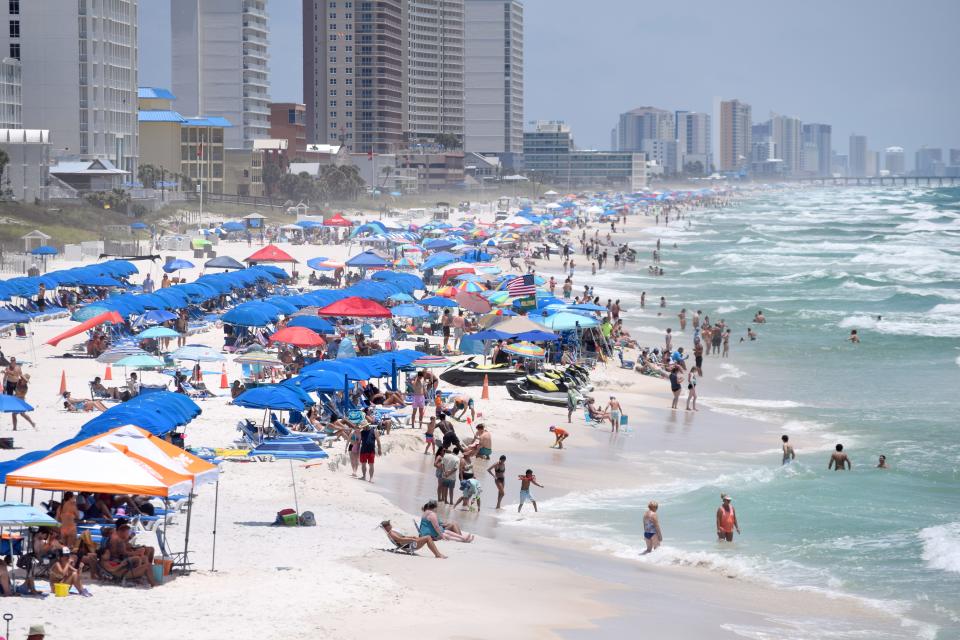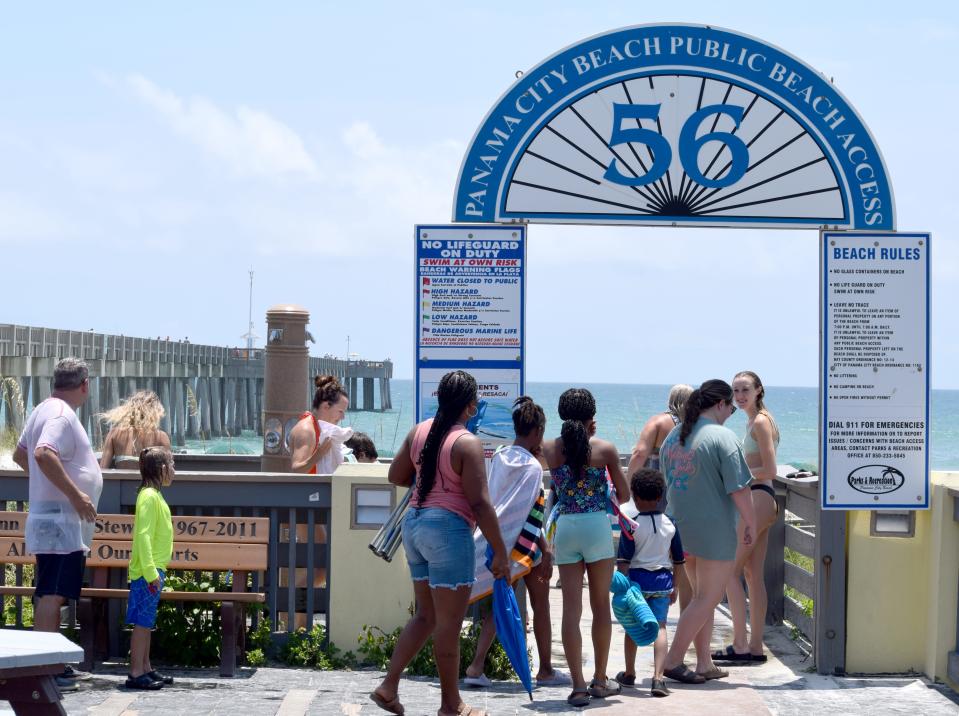'Everything is on the table': Panama City Beach area sees seven beach deaths in 10 days
Editor's note: This story has been revised to clarify that the deaths occurred during a 10-day period, and the headlines have been revised to clarify where the fatal water incidents occurred.
PANAMA CITY BEACH − Councilman Paul Casto says "everything is on the table at this point" when it comes to additional measures to help prevent future drownings.
From June 15-24, seven tourists died in Bay County after fighting strong rip currents in the Gulf of Mexico. Of these fatalities, six occurred within Panama City Beach limits, and one happened on an unincorporated beach. All but one were under double red flags.

"I can't speak for all my colleagues, but I feel like that we're going to continue to put as many resources as we can to help with this situation," Casto said. "We've made great progress in the history of the city, and I feel like we're going to continue doing whatever it takes ... (but) I don't know if you'll ever stop it completely."
Related coverage: Panama City Beach leads the nation in 2023 beach deaths as 3 more tourists die Saturday
These extra steps could include steeper fines and a zero tolerance policy for those in the water despite double red flags, as well as adding lifeguards and code enforcement officers in Panama City Beach.
PCB employees about 20 lifeguards who patrol approximately nine miles of beaches within the city limits. In addition to this area, there are other portions of the coast on the east and west end of the city that are overseen by Bay County.
At least two Beach lifeguards remained stationed in city towers on each side of the Russell-Fields Pier, which is located near Pier Park. The city's remaining lifeguards then patrol the nine miles of beaches, either on ATVs, in trucks or by jet skis.
Along with these lifeguards working to protect the coast, PCB has an ordinance that calls for those who enter the Gulf under double red flags to be cited $500 for their first offense and $1,000 for a second offense. However, this is largely overseen by code enforcement officers, and only two to four code enforcement officers patrol the coast at a given time enforcing the rule.
Ryan Mallett death: Former NFL and Arkansas quarterback Ryan Mallett drowned in Destin, Florida
The ordinance also requires that beachgoers receive a warning before they are ticketed. Offenders who pay their fines within 20 days of receiving the citation get a 50% discount.
In one of the recent fatal water incidents, Richard Alford, a 52-year-old retired firefighter from Georgia, died after attempting to rescue two swimmers who were fighting a rip current under double red flag conditions. They made it out alive, while Alford did not.
It should be noted such deaths are dubbed "fatal water incidents" by PCB, since it is technically not known whether the victims drowned or had another medical emergency in the water.
In Alford's case, the swimmers he tried to rescue should not have entered the Gulf in the first place, since it was illegal to swim at that time. The two unlawful beachgoers, however, were not cited, and officials have said it was partly because working code enforcement officers were busy in other areas of the beach.

"We will continue to try and educate the public about the hazards of rip currents, but unfortunately some of them choose to still ignore those warnings and go in the water," Casto said. "From what I know of these incidents, they knew the dangers and they chose to go in."
"I just don't know that there's a solution ... to stop it from happening if people defy the law."
Local citations: Panama City Beach has ticketed more than 70 for ignoring beach warnings
He also said Panama City Beach has experienced an abnormal number of double red flag days over the past couple weeks. According to daily text messages from ALERTBAY, a local emergency notification system, red or double red flags have flown every day in PCB since June 12. This means dangerous rip currents have existed along the coast that entire time.
The National Weather Service notes that these extremely rough conditions stem from strong onshore winds out of the southwest, which have led to higher surfs. An NWS database also states PCB has the highest number of beach fatalities for any single locale in the U.S. for 2023.
What is a rip current?
Rip currents are fast moving currents created by deep channels in surrounding sandbars. These channels often run perpendicular to the shoreline and cause water to funnel faster out into deeper waters of the Gulf. Rips can vary in strength, depending on how developed the channels are, and they can sometimes be identified from shore where there is a gap in the wave break − areas where the white caps of the breaks are less noticeable.
The best thing a beachgoer caught in a rip can do is swim parallel to shore, meaning toward the left or right of where they are in distress. If they do this, they will be able to break free from the current, often times landing on a sandbar where they can stand. If they still cannot stand, they will at least be in calmer water where it will be easier to make it back to shore.
Beach safety: How do you get out of a rip current? Some safety tips for beachgoers in Panama City Beach
Common flag colors used in beach flag warning systems include a green flag for low hazard conditions, a yellow flag for medium hazard conditions, one red flag for high hazard conditions and two red flags for very dangerous conditions.
Panama City Beach, however, never flies green flags because officials believe beachgoers should always be cautious anytime they enter the Gulf. Rip currents can always be present, even under clear skies and calmer surf conditions.
Beach visitors express their thoughts
Despite double red flags being posted, the beach was packed Friday near the Russell-Fields Pier. Among those beachgoers was Felipe Iglesias of Festus, Missouri, who said that while he understood why the water was closed, it still was upsetting.
Iglesias also said it can be financially draining since the beach is one of the main activities that tourists can do in Panama City Beach without spending a lot of money.
"Overall, it ruins it," he said of the closure's impact on his vacation. "Especially like us, whenever we have children (who) just want to enjoy the beach and swim. ... One of the least expensive things to do for a normal, mid-class family is the beach. When you don't have that, you come down here with a certain budget, and that gets blown out of the water."
That said, Iglesias, as well as Ocklawaha's Darci Darby, who also was at the beach Friday, were not aware that four tourists had died after swimming off the coast of Bay County in just one week leading up to that point. And little did they know, three more would die Saturday.
"People don't want want to listen to rules, that's the only reason why," Darby said of why she thinks some tourists still swim double red. "I have no problem staying out of the water. Do I stick my feet in there? Yes, but I will not let my daughter go in. ... She goes up to her ankles, and that's it."
This article originally appeared on The News Herald: Panama City Beach area records seven beach deaths in 10-day period

